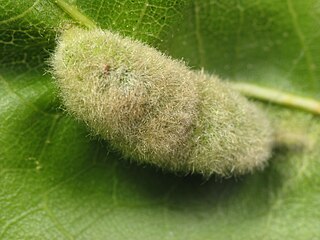
The Cecidomyiinae, commonly known as gall midges or gall gnats, is the largest subfamily in Cecidomyiidae with over 600 genera and more than 5000 described species. This subfamily is best known for its members that induce galls on plants, but there are also many species that are fungivores, parasitoids, or predators as maggots.

Contarinia is a genus of midges, small flies in the family Cecidomyiidae. There are over 300 described species in the genus.

Rabdophaga is genus of flies in the family of gall midges Cecidomyiidae. There are 105 species distributed through Africa, Asia, Europe and North America. Most species of Rabdophaga gall willows ; one exception is R. giraudiana which galls the stems of poplars.

Asphondylia is a cosmopolitan genus of gall midges in the family Cecidomyiidae. All species in this genus induce galls on plants, especially on flowers and flower buds. There are over 300 described species in Asphondylia, with many more likely to be discovered and described, especially in the southern hemisphere.

Asphondyliini is a tribe of gall midges in the family Cecidomyiidae. There are about six genera and at least 100 described species in Asphondyliini.
Alycaulini is a tribe of gall midges, insects in the family Cecidomyiidae. There are about 20 genera and at least 200 described species in Alycaulini.
Polystepha is a genus of gall midges in the family Cecidomyiidae. There are more than 20 described species in Polystepha.

Macrodiplosis is a genus of gall midges, insects in the family Cecidomyiidae. There are about 19 described species in Macrodiplosis.
Parallelodiplosis is a genus of gall midges, insects in the family Cecidomyiidae. There are at least 20 described species in Parallelodiplosis.

Asteromyia is a genus of gall midges in the family Cecidomyiidae. There are about nine described species in Asteromyia.

Resseliella is a genus of gall midges in the family Cecidomyiidae. There are at least 50 described species in the genus Resseliella.

Blaesodiplosis is a genus of gall midges in the family Cecidomyiidae. There are at least four described species in Blaesodiplosis.

Janetiella is a genus of gall midges in the family Cecidomyiidae. There are at least thirty described species.
Acericecis is a genus of gall midges in the family Cecidomyiidae. There are at least three described species in Acericecis.
Ampelomyia is a genus of gall midges in the tribe Asphondyliini. It consists of the following four species, all of which form galls on grape plants:

Harmandiola is a genus of flies belonging to the family Cecidomyiidae. The 14 described species are found in the Holarctic region. They induces galls on Populus, Castanea, and Carya.














